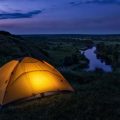1. Choosing the Right Campsite
If youre new to camping, picking the right spot to pitch your tent is one of the most important steps. A good campsite can make your trip more comfortable, safe, and enjoyable. Heres what you need to know before unrolling that sleeping bag.
What Makes a Good Campsite?
When choosing a location for your tent, youll want to keep a few key factors in mind: safety, comfort, and convenience. Whether youre at a national park or a local campground, here’s how to evaluate your options:
Key Considerations
| Factor | Why It Matters | Tips |
|---|---|---|
| Flat Ground | A level surface helps you sleep better and keeps your gear from sliding around. | Look for areas without slopes or dips. Avoid pitching on rocks or roots. |
| Shelter from Wind | Wind can shake your tent and lower temperatures. | Use natural windbreaks like trees or bushes for protection. |
| Drainage | You don’t want to wake up in a puddle after it rains. | Avoid low spots where water collects. Choose slightly elevated ground if possible. |
| Sun & Shade | Sunlight helps dry out dew, while shade keeps your tent cool during hot days. | Balance morning sun exposure with afternoon shade for best results. |
| Distance to Water | Being close to water is convenient but can attract bugs and wildlife. | Camp at least 200 feet away from lakes or streams as recommended by Leave No Trace guidelines. |
| Campground Rules | Breaking rules can result in fines or getting kicked out of the site. | Always check posted signs and follow local regulations about where you can set up tents. |
Weather Awareness
The weather can change quickly in the great outdoors. Before setting up camp, check the forecast and avoid exposed areas if high winds or storms are expected. During hot summer months, avoid wide open fields that offer no shade. In cooler weather, staying out of valleys can help prevent cold air from settling into your campsite overnight.
Pro Tip for First-Time Campers
If youre staying at a developed campground, ask the ranger or staff for recommendations on the best tent spots. Theyre usually happy to point you toward flat ground with good drainage and away from noisy neighbors or bright lights.
Quick Checklist for Choosing Your Tent Spot:
- Is the ground flat and free of debris?
- Is there natural protection from wind?
- Are you safely distanced from water sources?
- Is there a mix of sun and shade?
- Have you followed all campground rules?
A well-chosen campsite sets the stage for a great camping experience. Take a few extra minutes to find the right spot—you’ll thank yourself later when youre warm, dry, and getting a good night’s sleep under the stars.
2. Unpacking and Understanding Your Tent
Before diving into setting up your tent, take some time to get familiar with what’s inside the tent bag. This step may not seem exciting, but it makes the whole process way easier—especially if youre new to camping. Most tents come with several parts, and understanding how each piece fits together will save you time and frustration later.
What You’ll Typically Find in a Tent Bag
Every tent is a bit different, but most standard models include the following components:
| Component | Description |
|---|---|
| Tent Body | The main fabric part where you sleep. It usually includes mesh windows and doors. |
| Rainfly | An additional layer that goes over the tent to protect against rain and wind. |
| Poles | Usually made of aluminum or fiberglass, these create the frame of your tent. |
| Stakes (or Pegs) | Used to secure the tent to the ground so it stays in place. |
| Guylines | Cords that help stabilize the tent, especially in windy conditions. |
| Footprint (Optional) | A groundsheet that goes under your tent to protect it from dirt and moisture. |
Lay Everything Out
Once youve unpacked your gear, spread everything out on a clean, flat surface. Double-check that you have all necessary parts before moving forward. If anything’s missing, now’s the time to find out—not after dark at a remote campsite.
Match Components Together
If your poles are color-coded or shock-corded (connected by elastic), use those cues to figure out which ones go together. Try assembling them once without attaching them to the tent yet—just to see how they fit. Do the same for guylines and stakes. This “dry run” builds confidence and helps you understand the big picture of how your shelter comes together.
Pro Tip:
Take a photo of your fully unpacked tent setup with labeled parts. It’ll serve as a quick reference next time you camp!
Why This Step Matters
Getting acquainted with your tent pieces ahead of time can be a game-changer, especially if weather conditions shift quickly or if you’re arriving late at your campsite. The more prepared you are, the smoother everything else will go.
![]()
3. Laying the Groundwork
Before you even think about unrolling your tent, it’s important to prepare the area where you’ll set up camp. This step makes a big difference in keeping your tent comfortable, clean, and dry throughout your trip.
Clear the Area
Start by choosing a flat spot that’s free from rocks, sticks, and pinecones. These can poke through your tent floor or make sleeping uncomfortable. It’s also smart to avoid low-lying areas where water might collect if it rains.
What to Remove:
| Debris Type | Why Remove It |
|---|---|
| Rocks | Can damage your tent floor and make sleeping rough |
| Sticks & Twigs | Might poke through the groundsheet or create lumps under your sleeping bag |
| Pinecones or Nuts | Add unnecessary discomfort and may attract wildlife |
Lay Down a Tarp or Groundsheet
A tarp or groundsheet goes underneath your tent and acts as a protective barrier between your tent floor and the ground. This helps prevent moisture from seeping in and protects against wear and tear.
Tarp Tips:
- Size matters: Make sure the tarp is slightly smaller than your tent footprint so water doesn’t collect underneath during rain.
- Smooth it out: Lay it flat with no wrinkles to keep things even inside the tent.
Position Your Tent Properly
The way you face your tent can impact comfort and safety. Face the door away from strong winds for better stability and warmth. If youre near a scenic view, consider angling your door toward it for those peaceful morning views.
Orientation Checklist:
- Away from wind: Reduces flapping noise and keeps the interior warmer.
- Slight slope: If youre on a slight incline, position your head uphill for better sleep posture.
- Avoid direct sun: Pitching in partial shade helps keep the tent cooler during hot afternoons.
This groundwork sets you up for a smoother setup process and a much more enjoyable night under the stars. Take a few extra minutes here—it pays off later!
4. Assembling and Erecting the Tent
Now that youve chosen your campsite, laid down the footprint, and unpacked your gear, its time to put everything together. This part can feel intimidating for first-time campers, but don’t worry—we’ll walk you through each step in a simple and clear way.
Step 1: Connect the Tent Poles
Most modern tents come with shock-corded poles, which means they’re already connected by an elastic cord inside. Just unfold and let them snap into place. Lay them out next to your tent so you know where each one goes.
Tip:
- If your tent has color-coded poles and sleeves, match the colors—it makes setup much easier.
- Keep the poles away from direct force when bending; let the curve form naturally.
Step 2: Insert Poles into Tent Sleeves or Clips
Depending on your tents design, you’ll either feed the poles through fabric sleeves or clip them onto hooks attached to the tent body.
| Tent Style | How to Attach Poles |
|---|---|
| Sleeve-style | Slide poles fully through fabric sleeves, then secure ends into corner grommets. |
| Clip-style | Attach pole clips onto the standing poles after placing ends in corner grommets. |
Step 3: Raise the Tent Structure
Once all poles are attached and secured, gently lift the structure upright. You may need a second person to help balance it while inserting pole ends into grommets or stake loops at the base of the tent corners.
Tip:
- Start with two opposite corners and work diagonally across for better stability.
- If it’s windy, have someone hold the tent as you raise it to prevent it from blowing away.
Step 4: Stake Down the Corners
Use stakes to secure each corner of your tent to the ground. Push or hammer stakes at a 45-degree angle pointing away from the tent for maximum grip. Make sure all four corners are taut but not overly stretched.
You’ll Need:
- Tent stakes (usually included with your tent)
- A rubber mallet or rock (to drive stakes into firm ground)
Step 5: Adjust Guy Lines for Extra Stability
If your tent includes guy lines (those extra cords attached near the rainfly), extend them out and stake them into the ground a few feet from the tent. These provide added support against wind and help keep your rainfly tight and dry.
Guy Line Setup Tips:
- Pull guy lines until taut but avoid over-tightening which could stress fabric seams.
- Use tensioners if available to make easy adjustments throughout your trip.
You’ve now got a solid setup! With a bit of practice, assembling your tent will become second nature on future camping trips.
5. Final Checks and Weatherproofing
Before you kick back and enjoy the great outdoors, it’s important to double-check your tent setup. A few quick inspections can make all the difference in staying safe, dry, and comfortable overnight—especially if the weather turns. Here’s how to make sure your tent is good to go.
Inspect Your Tent Setup
Walk around your tent and check for any signs of uneven pitching or sagging fabric. Make sure all poles are fully connected and inserted into their correct sleeves or clips. If your tent looks lopsided or loose, take a moment to adjust it before moving on.
Checklist for Inspection:
| Area | What to Check |
|---|---|
| Pole Connections | Ensure all poles are fully extended and securely in place |
| Tent Fabric | Look for sagging areas or fabric not pulled taut |
| Zippers & Doors | Test zippers to make sure they close smoothly without snags |
| Stakes & Guy Lines | Confirm they’re tight and driven at a 45° angle into the ground |
Tighten Loose Areas
If you notice any flapping or slack, use the tent’s adjustment points to tighten it up. Many tents have adjustable straps at the corners—pull these snug so the tent stands firm. Also, re-stake any lines that look loose or out of position.
Pro Tip:
A taut tent isn’t just about looks—it helps prevent rainwater from pooling on top and reduces wind noise at night.
Weatherproofing for Wind and Rain
You never know when the weather might change, so it’s smart to prepare ahead of time. Here are some basic steps to keep your tent protected from the elements:
- Rainfly: Always attach your rainfly, even if skies are clear. It acts as an extra barrier against rain and dew.
- Guy Lines: Secure guy lines tightly and stake them out away from the tent—this helps stabilize against wind gusts.
- Tent Footprint: Make sure your ground tarp doesn’t stick out past the edges of your tent; otherwise, water can collect underneath during rain.
- Zippered Windows: Close windows and vents if rain is expected but leave small openings for airflow to reduce condensation inside.
Double-Check Before You Settle In
Once everything is secure and weather-ready, step back and give your setup one last look. Shake the tent gently to see if anything shifts. If it stands firm and looks solid—you’re ready to move in! A little extra effort now ensures a smoother camping experience later on.


